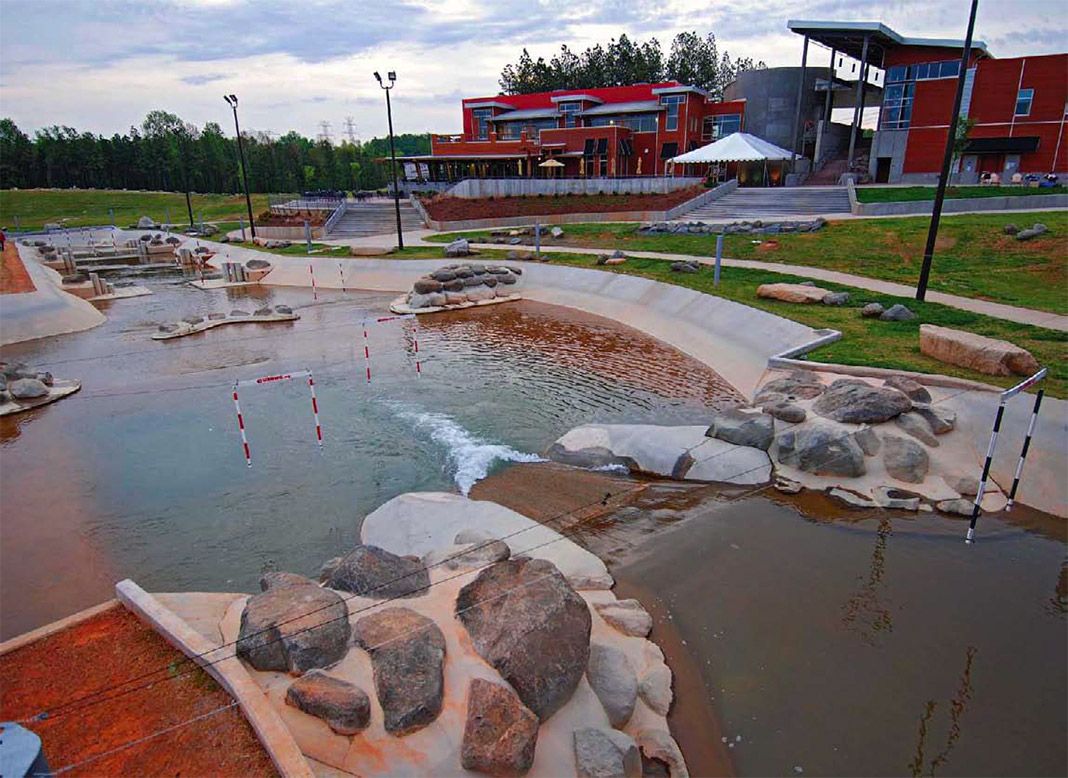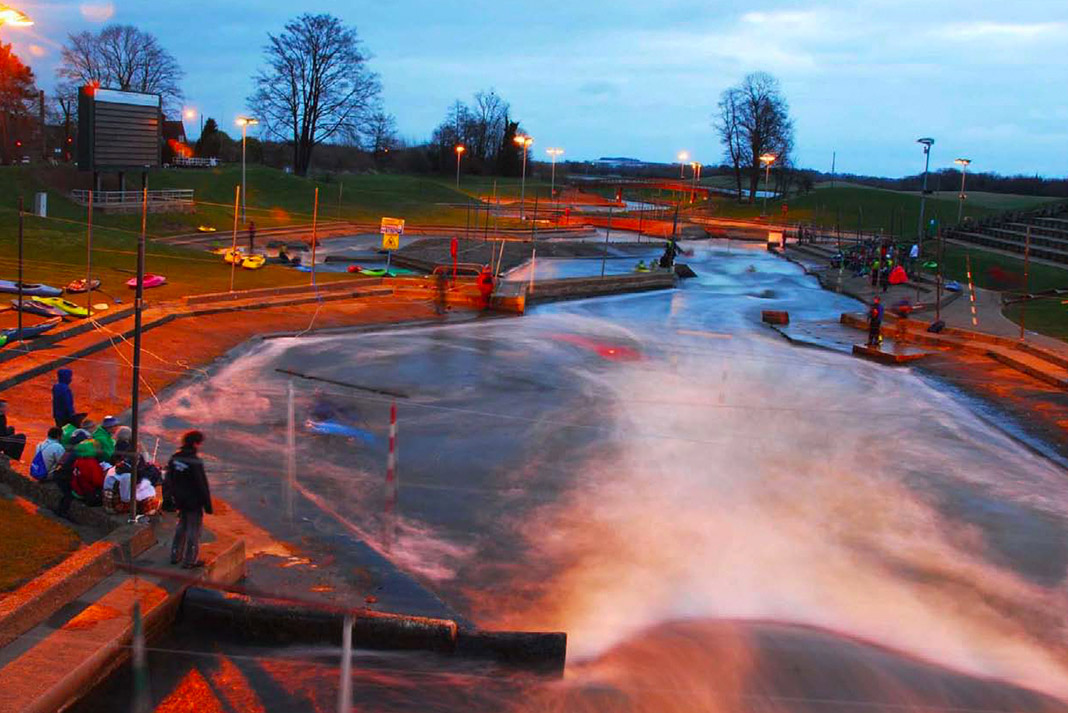Once upon a time, the city of Grand Rapids, Michigan lived up to its namesake. The Grand River tumbled six vertical meters over a distance of 2 km through the city’s center on its way to Lake Michigan. Then came the construction of North America’s first hydroelectric facility in 1880, kicking off a century of urbanization. The river was straightened and channeled over a series of concrete weirs, and it was even proposed to be paved-over for a parking lot.
“The Grand looks like a drainage ditch right now,” says local kayaker Chris Muller. “It’s a leftover from the industrial days when it was a place to gain power and get rid of sewage.”
Muller and his buddies Chip Richards and Roger Starring are downing pints of Dirty Bastard Scotch-style ale at Grand Rapids’ Founders Brewery and Taphouse when I chat with them over a sketchy mobile phone conference call. For the past year the threesome’s Grand Rapids WhiteWater (GRWW) organization has been spearheading a proposal to “put the rapids back in the Grand” in the form of a downtown whitewater paddling course. The proposed take-out, coincidently or not, would be on the doorstep of their favourite downtown brewpub.
While Richards and Muller have been dreaming of a whitewater park in downtown Grand Rapids for five years, the plan became more of a reality when the city of 197,000 launched a “green” urban development strategy in 2008. GRWW lobbied that a whitewater park was an ideal fit. Re-engineering the Grand River would enable fish migration and remove a handful of dangerous low-head dams.
Citing the economic figures of downtown whitewater parks in other U.S. cities, the organization argued that a kayak course on the Grand would draw locals and tourists and inject millions of dollars into the city’s core. For example, the weekend-long Reno River Festival, held each May in downtown Reno, Nevada on the Truckee River—a former concrete and rebar sluiceway itself—brings in 40,000 people and upwards of $4 million in revenue.
Grand Rapids Mayor George Heartwell and the city’s Downtown Development Agency took note: a whitewater park became a priority in the city’s Green Plan, and the downtown agency promised $25,000 for a feasibility study and initial plan.
Across the United States and Canada, boaters like Muller, Richards and Starring, engineers and city councils are rallying around whitewater parks as the future of paddling and a cornerstone of intelligent urban design. In late May, the three factions will convene for the third Whitewater Courses and Parks conference in Salida, Colorado to discuss “issues important to river parks’ environmental and economic sustainability.”
According to conference organizer Risa Shimoda, a marketing expert, boater and chair of the International Whitewater Hall of Fame, whitewater paddling is approaching a “tipping point” in becoming part of the urban recreation vernacular. “If every city had one along with their basketball courts,” she says, “the sport would change dramatically.”

The whitewater park boom
Paddlers are opportunistic when it comes to making the best of altered waterways. Boaters queue up for the pre-determined water releases of dammed rivers around the world. Human-made features like Lock 19 in Peterborough, Ontario and Scudders Falls on Pennsylvania’s Delaware River are playboating favourites. Similarly, the whitewater playground of the Ottawa River was shaped in part by decades of log-driving and hydroelectric development. Minden’s Gull River is a well-used training ground for slalom paddlers in southern Ontario.
“If it weren’t for maintaining water levels on the Trent-Severn Canal, the Gull would be a hiking trail in the summer,” says local boater Jeff Strano, the manager of Algonquin Outfitters’ Boatwerks. “I think a lot of people are under the illusion that these rivers are the result of Mother Nature and nothing else. That’s a fallacy.”
Organizers of the 1972 Olympics took whitewater to a new level when they dynamited, hauled boulders and pumped water to create a kayak course in Augsburg, Germany for the Summer Games. Six years before, the Arkansas River in Salida, Colorado was reconfigured specifically for whitewater paddling. After Augsburg and Salida became the world’s first artificial and in-stream whitewater parks, the concept of engineering and excavating recirculating “rivers” or converting dull, dammed and sometimes polluted natural waterways into paddling hotspots didn’t catch on in earnest until 1990. That’s when Gary Lacy, a kayaker and civil engineer, created Boulder Creek Park in Boulder, Colorado, thus beginning the whitewater park boom and the state’s reign as the world’s capital of engineered whitewater.
Lacy’s Boulder-based Recreation Engineering and Planning company has built the lion’s share of North America’s 50-odd whitewater parks. “He’s the godfather of these things,” says Scott Shipley, the engineer who worked with Lacy in 2006 to create Charlotte, North Carolina’s $36-million U.S. National Whitewater Center, an artificial, pay-to-paddle facility that features a massive conveyor belt to shuttle boaters from the bottom to the top of the course. Denver’s McLaughlin Whitewater Design Group is another key player in the industry, having designed North America’s only other artificial park, McHenry, Maryland’s Adventure Sports Center International, in 2007.
But Shipley is the field’s rising star and one of its loudest proponents. Best known for competing at the 1992, 1996 and 2000 Olympic Games and winning three K1 slalom World Cup championships, Shipley has become a leader in whitewater park design. Currently, he’s putting the finishing touches on London, England’s whitewater venue for the 2012 Olympics. The Broxbourne Whitewater Park is entirely human-made, pumping water from an 11,500-square-meter reservoir and channeling it down consecutive 160- and 300-meter courses at rates of up to 15 cubic metres per second. Like a climbing wall, Shipley’s course is entirely modular: Flow can be altered by changing the course’s gradient, and patented obstructions known as Rapidblocs can be reconfigured to create different features.
“My first designs were well within the box of conventional thinking,” says Shipley. “But in London, they said, ‘go out and create whatever you can imagine.’ The next generation of whitewater parks will reinvent the whitewater experience and evolve the sport.” Shipley curbs his enthusiasm when asked what the future of whitewater parks will be. “The future is a secret right now,” he says. But he promises that the new London facility is “a flash of what to expect.”
The freedom to paddle year-round
The future may someday be dominated by boaters like Jason Craig, the 16-year-old 2009 world junior freestyle champion, who learned to loop, helix and pan-am in the whitewater park on Reno’s Truckee River. Shimoda says parks play two roles in developing future freestyle stars: Making paddling easily available to masses of people, and making it safe. Society’s general fear of water is reduced when whitewater is made more accessible and controlled, similar to what indoor gyms and halfpipes have done for climbing and snowboarding, she says. “The key is when the kid asks the mom or dad to go kayaking, the parents have to be okay with it.”
It makes sense that the precise, ordered world of whitewater slalom has also gravitated to engineered whitewater. The Canadian team trains extensively at Rutherford Creek, Canada’s most complete whitewater park facility in Pemberton, B.C., and the U.S. national team is based at the artificial course in Charlotte. As much as U.S. coach Cathy Hearn, a longtime slalom competitor, misses “migrating like gypsies from river to river depending upon the season,” and the ad-lib, reactionary skills developed by paddling wild rivers, she says artificial parks offer broader exposure to the public and potential sponsors, consistent training and better coaching—not to mention on-site showers and nearby accommodations. “Gone are the days of sleeping in your wetsuit so it won’t freeze overnight,” she says.
For recreational paddlers, like Grand Rapids’ Muller, Richards and Starring, whitewater parks mean the freedom to paddle—often year-round—without making a road trip. It goes without saying that cities with these opportunities have a markedly higher number of paddlers. Colorado has long been a boating stronghold; world-class freestyle boaters Jay Kincaid and Canadian Ruth Gordon migrated to Reno; and in Charlotte, Shipley says the U.S. National Whitewater Center introduced nearly 1,000 people to kayaking in its first six months alone.
In Colorado, whitewater parks are becoming central to sustainable urban design. Jed Selby was only 24 years old when the lifestyle of professional kayaking started to burn him out. The former World Cup freestyle competitor has since become the developer of an environmentally conscious neighbourhood on the Arkansas River in Buena Vista, Colorado (pop. 2,200), a sleepy town in the Rocky Mountain foothills southwest of Denver. Selby and his sister, Katie Urban, found a goldmine when they happened upon 10 hectares of riverside land adjacent to downtown Buena Vista in 2003. The siblings convinced their father to help finance the $1.2-million price tag, and South Main was born.
A whitewater park became part of their urban development theory—along with 500 units of residential and commercial property. With house prices ranging from $200,000 to $1.5 million, however, Selby admits that his neighbourhood will never be overrun by dirtbags. As South Main, like all other whitewater parks, broadens the demographics of paddling, it hints that perhaps the activity is maturing. “Hanging out at the Slave [River], getting attacked by mosquitoes, is only fun for so long,” says Selby. “I didn’t want to be living in my car on the side of the highway my whole life.”

The shock of trying the real thing
The proliferation of human-made whitewater begs a couple of questions: Does creating a virtual reality of what’s long been defined by an organic, risky and high-skill experience change the essence of whitewater paddling? And are today’s up and coming park boaters missing out on skills and savvy honed only on wild, free-flowing rivers?
The generation of paddlers who learn their skills exclusively in parks with designer waves and carefully conceived eddies will be in for a shock when they launch into a natural river and try the real thing. Whitewater parks are controlled environments with safety procedures and sometimes even lifeguards. They do not have undercuts, sieves, strainers, deadly hydraulics or no-eddy gorges. They never force boaters to weigh the risks of running a drop blind. A park boater will never have to hike out of an unrunnable canyon, or know the joy of sighting water through the trees at the end of a difficult portage.
But as an engine of growth, whitewater parks cannot be questioned. They simplify boating for beginners and veteran paddlers alike. “There’s something to be said about setting a shuttle and running a river,” says Kincaid. “But there’s also something nice about paddling on your lunch hour.”
Beyond the role of parks in the growth of the sport, Strano believes bringing whitewater to population centres like southern Ontario’s Golden Horseshoe is necessary for the salvation of wild rivers. Park boaters are potential river stewards waiting in the wings. “After a whitewater park,” says Strano, “real rivers are only a short step away.”
In-stream whitewater parks on once-feral rivers like Michigan’s Grand inject new life into these long-restrained waterways. The benefits are two-fold—for townsfolk and boaters living near these rivers, and for the health of the aquatic ecosystem. Artificial parks can be built anywhere with adequate funding and revenue base—no river required—and represent the true paddle anywhere vision of proponents like Shipley and Shimoda. As facilities like the U.S. National Whitewater Center prove to be economically viable, others are springing up around the world.
Like it or not, in a world of ever-shrinking attention spans and ever-increasing consumption of packaged adventure, whitewater parks will play a critical role in the future of our sport—economically, if not spiritually. “We’re no longer in a world where people go out and seek these things way out in the woods,” summarizes Shipley, “[whitewater parks] put these things right in the centre of the existence of Generation Y.”
Conor Mihell is a writer based in Sault Ste. Marie, ON.
Urban Oasis: Whitewater Parks can transform neglected areas and generate lively new paddling communities. | Photo: Mathew Corke




